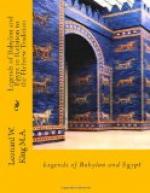The expression Belit-ili, “the Lady of the Gods”, is attested as a title borne both by the Semitic goddess Ishtar and by the Sumerian goddess Nintu or Ninkharsagga. In the passage in the Babylonian Version, “the Lady of the Gods” has always been treated as a synonym of Ishtar, the second half of the couplet being regarded as a restatement of the first, according to a recognized law of Babylonian poetry. We may probably assume that this interpretation is correct, and we may conclude by analogy that “the holy Innanna” in the second half of the Sumerian couplet is there merely employed as a synonym of Nintu.(1) When the Sumerian myth was recast in accordance with Semitic ideas, the role of creatress of mankind, which had been played by the old Sumerian goddess Ninkharsagga or Nintu, was naturally transferred to the Semitic Ishtar. And as Innanna was one of Ishtar’s designations, it was possible to make the change by a simple transcription of the lines, the name Nintu being replaced by the synonymous title Belit-ili, which was also shared by Ishtar. Difficulties are at once introduced if we assume with Dr. Poebel that in each version two separate goddesses are represented as lamenting, Nintu or Belit-ili and Innanna or Ishtar. For Innanna as a separate goddess had no share in the Sumerian Creation, and the reference to “her people” is there only applicable to Nintu. Dr. Poebel has to assume that the Sumerian names should be reversed in order to restore them to their original order, which he suggests the Babylonian Version has preserved. But no such textual emendation is necessary. In the Semitic Version Ishtar definitely displaces Nintu as the mother of men, as is proved by a later passage in her speech where she refers to her own bearing of mankind.(2) The necessity for the substitution of her name in the later version is thus obvious, and we have already noted how simply this was effected.
(1) Cf. also Jastrow, Hebr. and Bab. Trad., p. 336.
(2) Gilg. Epic, XI, l. 123.
Another feature in which the two versions differ is that in the Sumerian text the lamentation of the goddess precedes the sending of the Deluge, while in the Gilgamesh Epic it is occasioned by the actual advent of the storm. Since our text is not completely preserved, it is just possible that the couplet was repeated at the end of the Fourth Column after mankind’s destruction had taken place. But a further apparent difference has been noted. While in the Sumerian Version the goddess at once deplores the divine decision, it is clear from Ishtar’s words in the Gilgamesh Epic that in the assembly of the gods she had at any rate concurred in it.(1) On the other hand, in Belit-ili’s later speech in the Epic, after Ut-napishtim’s sacrifice upon the mountain, she appears to subscribe the decision to Enlil alone.(2) The passages in the Gilgamesh Epic are not really contradictory, for they can be interpreted as implying that, while Enlil forced




